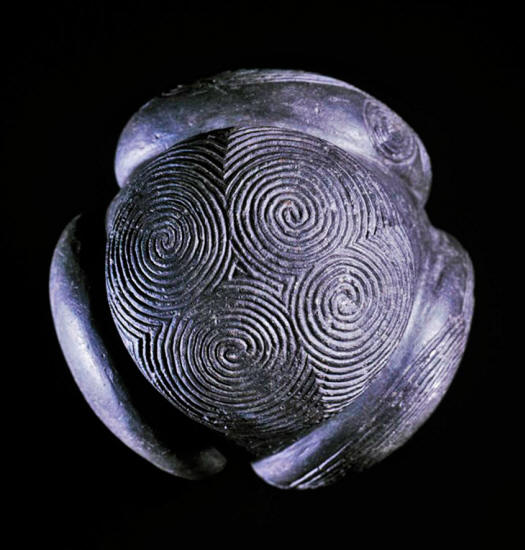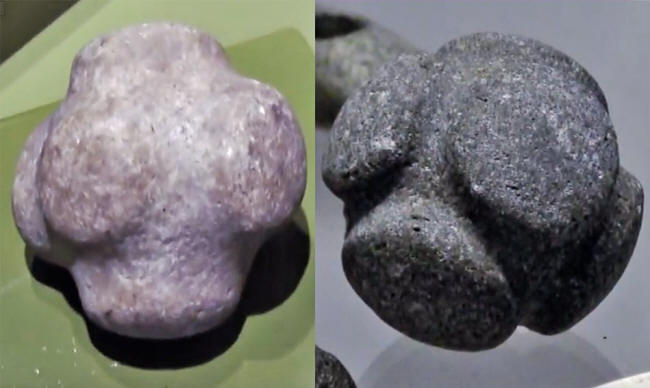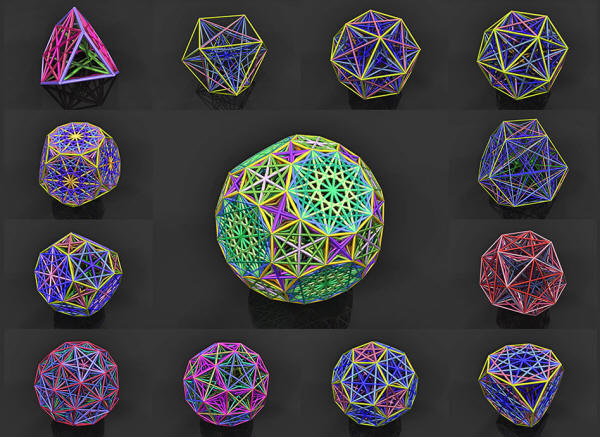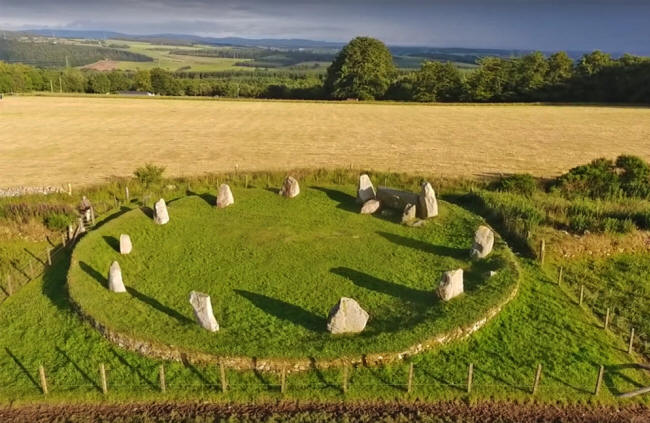|

by Janice Friedman
August 06,
2019
from
Ancient-Code Website

Towie ball
Hundreds of intricately carved stone spheres about the size of a
tennis ball or larger have been found all over Northern Scotland,
Ireland, and in England.
Some are irregular
asymmetrical spheres featuring organic-looking protrusions.
Others have intricate
geometric patterns, lines, and circles carved on their surface.
While most are spherical, some are shaped more like starfish,
with protruding legs.
They date to 3000-2600 BC
and may have been created by
the Picts, Celtic language-speaking
peoples.
Why did the ancient
people carve sophisticated geometry onto these spheres made of
all kinds of rock? Many were found near Neolithic
stone circles
in grassy fields, adding to the mystery.
Why were they placed
in the proximity of these ancient circles?
That's what Hugh
Newman (below video), author, Megalithic researcher, and
explorer asks as he takes us on a tour of the spheres in Scottish
museum collections in Orkney, Aberdeen, Glasgow, Oxford, and
Edinburgh and London, England.
Surprisingly, Newman then arrives across the world in the South
American country of Bolivia where he spots a virtually identical
sphere.
"Were they really
associated with these stone circles? It certainly seems so.
Even though they
weren't found directly in stone circles, they were found in the
fields around them. This really intrigues me, because, if that's
the case, why were they placing them in the fields?" asks
Newman.
One of the spheres is
particularly intricate, the famous
Towie ball found in Aberdeenshire.
It's thought to be over
5,000 years old, is almost three inches across and covered with
incredibly intricate spirals. According to the National Museums
Scotland, it may have been a weapon and a symbol of power.
If so,
How or why did they
end up abandoned in fields?
Why are so few of
these spheres damaged or chipped?
According to the Museum
website:
"The ball would have
been the possession of a well-off Neolithic farmer. It could
well have been a fancy weapon, capable of dealing a painful blow
to the head if thrown from a sling.
But it was first and
foremost a symbol of power - an elite weapon of social
exclusion! - adorned with sacred symbols that resemble those
carved into the stones of a faraway passage tomb at Newgrange in
the Boyne Valley of eastern Ireland."
You can rotate the Towie
ball in 3d along with many other spheres from National Museums
Scotland below:
Neolithic carved stone balls, Scotland
by National Museums Scotland
Along with the spheres, relief carvings of spirals and geometric
shapes have been found, but not just in Scotland.
Over 6000 miles
away at the site of
Tiwanaku in Bolivia, similar carvings are found.
Meanwhile, at Lake Titicaca, Newman found a stone sphere with six
sides that closely resembles one of the Scottish stone spheres.
It's
on display at the Tiwanaku Museum in La Paz, Bolivia.

Sphere from Bolivia on the left.
Sphere from Scotland on the right.
Image screenshots via YouTube
Such patterns are found all over the planet.
Some are saying it's more evidence of an ancient advanced worldwide
civilization.
Spherical metal objects dating back 6,000 years have been found near
the Dead Sea in the treasure of
Nahal Mishmar in the Judean Desert.
They were made of copper and thought to represent the Sun.
Could the
Scottish stones have represented the Sun or Moon?
There are an endless array of ideas about what these objects were
used for, from weapons to massage tools, healing stones, to weights,
to tools used to roll larger stones.
However, since most of the
spheres are in relatively good shape, their use as weapons or tools
seems less likely.
The placement in fields might indicate some use concerning growing
crops, with some suggesting that magnetic fields or natural energies
were at work.
On the other hand, could the beautifully carved stones
have been offerings to the gods left as gifts in the hopes of a
bountiful harvest?
Newman believes the intricate carvings might be references to sacred
geometry or Archimedean and Platonic solids. These are complex
polyhedra shapes enumerated by Archimedes and Plato.
If so,
does
this indicate that Neolithic people had an advanced understanding of
mathematics?

Archimedean and Platonic solids
by fdecomite via Flickr (CC BY 2.0)
Another idea is that the elaborate shapes may have had some use in
surveying and astronomy, considering their proximity to the stone
megalithic circles.
These were places to observe seasonal changes
and the stars, Moon, and planets.
Perhaps these spheres were placed
on the ground to mark the location in the sky of these celestial
bodies?
Nobody knows why the spheres were found near the stone
observatories but not within.

Neolithic stone circle
via YouTube
Today we recognize some of these shapes as similar to the atomic or
cellular structure...
It seems impossible that ancient people would
know of such things. However, since we don't know anything about who
made these objects or why we can't rule it out entirely.
|





